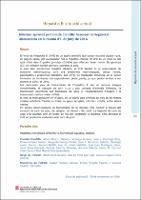Hepatitis E: situació actual. Informe aprovat pel Comitè Científic Assessor de Seguretat Alimentària en la reunió d ’ 1 de juny de 2016
Resum
El virus de l’hepatitis E (VHE) és un agent zoonòtic que causa hepatitis aguda que, en alguns casos, pot evolucionar fins a hepatitis crònica. El VHE és un virus nu del qual s’han descrit quatre
genotips (G1-G4) que infecten l’ésser humà. Els genotips G3 i G4 infecten també animals, sobretot el porc. A més dels símptomes hepàtics clàssics, el VHE també és el responsable de trastorns extrahepàtics, com ara síndromes neurològiques, danys renals, pancreatitis i problemes hemàtics.
Les xifres de mortalitat femenina en el tercer trimestre de l’embaràs són especialment preocupants, ja que poden arribar a ser d’entre el 15% i el 25%.
Les principals vies de transmissió de l’hepatitis E són el consum d’aigua contaminada, el consum de carn crua o poc cuinada d’animals infectats, la transmissió parenteral per transfusió de sang o trasplantament d’òrgans i la transmissió vertical maternofilial.
El VHE és molt prevalent en el porc, on un 100% dels animals de més de sis mesos n’estan infectats. També es troba en porcs senglars, cérvols i conills, entre altres hostes.
En països desenvolupats, la transmissió de la infecció s’ha produït a través del consum de carn de porc, de senglar, de cérvol o de conill. La ingestió de carn de caça s’ha apuntat com un factor de risc per contreure la malaltia. S’ha detectat el VHE en productes elaborats amb carn de porc.
Paraules clau
Hepatitis; Transmissió alimentària; Transmissió aquàtica; Zoonosi
Citació recomanada
Hepatitis E: situació actual. Informe aprovat pel Comitè Científic Assessor de Seguretat Alimentària en la reunió d ’ 1 de juny de 2016. Barcelona: Agència Catalana de Seguretat Alimentària; 2016.
Audiència
Professionals
Empreu aquest identificador per citar i/o enllaçar aquest document
https://hdl.handle.net/11351/2724Aquest element apareix a les col·leccions següents
Els següents fitxers sobre la llicència estan associats a aquest element:

